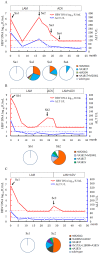rtM204Q may serve as a novel lamivudine-resistance-associated mutation of hepatitis B virus
- PMID: 24586482
- PMCID: PMC3933355
- DOI: 10.1371/journal.pone.0089015
rtM204Q may serve as a novel lamivudine-resistance-associated mutation of hepatitis B virus
Abstract
Background and aims: Lamivudine (LAM) is still widely used for anti-HBV therapy in China. The study aimed to clarify whether a newly-found rtM204Q mutation from patients was associated with the drug resistance.
Methods: HBV complete reverse-transcriptase region was screened by direct sequencing and verified by clonal sequencing. Replication-competent plasmids containing patient-derived 1.1mer mutant or wild-type viral genome were constructed and transfected into HepG2 cells. After cultured with or without serially-diluted antiviral drugs, intracellular HBV replicative intermediates were quantitated for calculating the 50% effective concentration of drug (EC₅₀).
Results: A total of 12,000 serum samples of 9,830 patients with chronic HBV infection were screened. rtM204Q mutation was detected in seven LAM-refractory patients. By contrast, rtM204I/rtM204V mutations were detected in 2,502 patients' samples. The rtM204Q emerged either alone or in concomitance with rtM204I/rtM204V, and all were accompanied with virologic breakthrough in clinical course. Clonal sequencing verified that rtM204Q mutant was predominant in viral quasispecies of these samples. Phenotypic analysis showed that rtM204Q mutant had 89.9% of replication capacity and 76-fold increased LAM EC₅₀ of the concomitant wild-type strain. By contrast, rtM204I mutant in the sample had lower replication capacity and higher LAM resistance (46.3% and 1396-fold increased LAM EC₅₀ of the wild-type strain) compared to rtM204Q mutant. rtM204Q mutant was susceptible to adefovir dipivoxil (ADV) in vitro and ADV/ADV+LAM rescue therapy in clinic.
Conclusion: rtM204Q is suggested to be a novel LAM-resistance-associated mutation. It conferred a moderate resistance with higher competent natural replication capacity compared to rtM204I mutation.
Conflict of interest statement
Figures


Similar articles
-
Investigation into drug-resistant mutations of HBV from 845 nucleoside/nucleotide analogue-naive Chinese patients with chronic HBV infection.Antivir Ther. 2015;20(2):141-7. doi: 10.3851/IMP2813. Epub 2014 Jul 3. Antivir Ther. 2015. PMID: 24992206
-
The rtA181S mutation of hepatitis B virus primarily confers resistance to adefovir dipivoxil.J Viral Hepat. 2015 Mar;22(3):328-34. doi: 10.1111/jvh.12298. Epub 2014 Aug 14. J Viral Hepat. 2015. PMID: 25132017
-
Screening and identification of a novel adefovir dipivoxil resistance associated mutation, rtN236V, of HBV from a large cohort of HBV-infected patients.Antivir Ther. 2014;19(6):551-8. doi: 10.3851/IMP2775. Epub 2014 Apr 8. Antivir Ther. 2014. PMID: 24710668
-
Impact of the rtI187V polymerase substitution of hepatitis B virus on viral replication and antiviral drug susceptibility.J Gen Virol. 2014 Nov;95(Pt 11):2523-2530. doi: 10.1099/vir.0.066886-0. Epub 2014 Jul 15. J Gen Virol. 2014. PMID: 25028473 Free PMC article.
-
Prevalence, virology and antiviral drugs susceptibility of hepatitis B virus rtN238H polymerase mutation from 1865 Chinese patients with chronic hepatitis B.Antiviral Res. 2012 Jan;93(1):185-90. doi: 10.1016/j.antiviral.2011.11.012. Epub 2011 Nov 26. Antiviral Res. 2012. PMID: 22138714
Cited by
-
Complementation of Wild-Type and Drug-Resistant Hepatitis B Virus Genomes to Maintain Viral Replication and Rescue Virion Production under Nucleos(t)ide Analogs.Virol Sin. 2019 Aug;34(4):377-385. doi: 10.1007/s12250-019-00143-y. Epub 2019 Jun 19. Virol Sin. 2019. PMID: 31218588 Free PMC article.
-
Hepatitis B virus mutation pattern rtL180M+A181C+M204V may contribute to entecavir resistance in clinical practice.Emerg Microbes Infect. 2019;8(1):354-365. doi: 10.1080/22221751.2019.1584018. Emerg Microbes Infect. 2019. PMID: 30866789 Free PMC article.
-
Characterization of Novel Hepatitis B Virus PreS/S-Gene Mutations in a Patient with Occult Hepatitis B Virus Infection.PLoS One. 2016 May 16;11(5):e0155654. doi: 10.1371/journal.pone.0155654. eCollection 2016. PLoS One. 2016. PMID: 27182775 Free PMC article.
-
Variable Proportions of Phylogenetic Clustering and Low Levels of Antiviral Drug Resistance among the Major HBV Sub-Genotypes in the Middle East and North Africa.Pathogens. 2021 Oct 15;10(10):1333. doi: 10.3390/pathogens10101333. Pathogens. 2021. PMID: 34684283 Free PMC article.
-
HBV Drug Resistance Substitutions Existed before the Clinical Approval of Nucleos(t)ide Analogues: A Bioinformatic Analysis by GenBank Data Mining.Viruses. 2017 Jul 27;9(8):199. doi: 10.3390/v9080199. Viruses. 2017. PMID: 28749433 Free PMC article.
References
-
- World Health Organization (2012) Hepatitis B fact sheets. Available: http://www.who.int/mediacentre/factsheets/fs204/en/. Updated on July, 2013. Accessed on January 1, 2013.
Publication types
MeSH terms
Substances
LinkOut - more resources
Full Text Sources
Other Literature Sources

